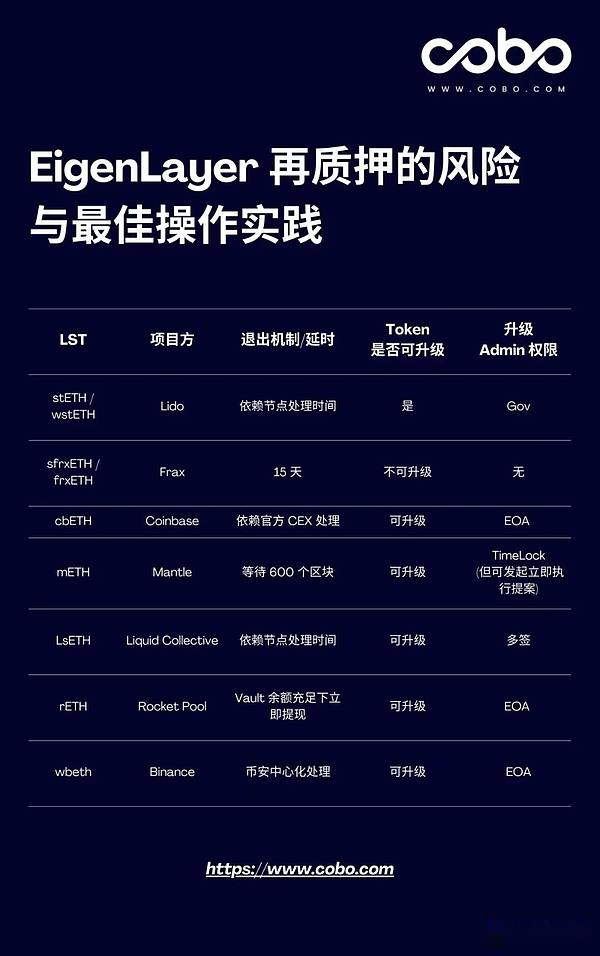
Author: COBO Security Team
With the rise of RESTAKING, there are more RESTAKING projects based on Eigenlayer on the market.RestAKING intends to share the user’s pledge share with other projects by sharing the trust of the Ethereum Beacon pledge layer, so that the user can get more benefits, so that other projects can also enjoy the same consensus trust and security as the ETH Beacon layer.Essence
In order to help everyone better understand the interactive risks between different RESTAKING projects, the COBO security team investigated the mainstream RESTAKING protocol and mainstream LST assets on the market, and sorted out related risks.Can better control the corresponding risks.
-
Note: The relevant conclusions listed by the COBO security team are based on UTC time before 0pm on February 5, 2024.
Risk point overview
At present, the RESTAKING protocol on the market is basically constructed based on Eigenlayer. For users, participating in RESTAKING means exposing itself in the following risks:
Contract risk
-
At present, participating in RESTAKING need to interact with the project party contract, and users need to bear the risk of being attacked by the contract;
-
Project funds based on EIGENLAYER will eventually be stored in contracts in the EIGENLAYER protocol. If the Eigenlayer contract is attacked, the relevant project funds will be lost;
-
In Eigenlayer, there are two RESTAKING types, namely Native Eth Restaking and Lst RSTAKING.For LSTRESTAKING, funds are directly stored in the Eigenlayer contract.But for Native Eth RestAKing, funds are stored in ETH Beacon Chain; this means that users who perform LSTRESTAKING may suffer losses due to EIGENLAYER contract risks;
-
The project party has high -risk authority, and in some cases, user funds can be misappropriated through sensitivity permissions.
-
The LST token is possibly possibly anchoring, or the LST contract upgrade/attacked leads to the deviation and loss of LST value.
-
Except for Eigenlayer, the mainstream RESTAKING protocols on the market do not support withdrawal.Assuming that the project party does not upgrade the corresponding withdrawal logic through the contract, users can never get back assets, and they need to obtain liquidity exit from the secondary market.
-
The completion of the project is low, and most of the projects have not realized the logic of withdrawal of withdrawals;
-
Central risk: User assets are finally controlled by more wallets.The project party has a certain RUG PULL ability;
-
Based on the second point, when the internal evil or the loss of the private key occurred, the asset loss may be caused.
-
EIGENLAYER is currently deployed in the main network contract, and has not yet fully implemented all functions in its white paper (AVS, Slash).Among them, the SLASH function only achieves relevant interfaces, and there is no specific complete logic.According to the contract code, the current SLASH is triggered by Owner (the project party Admin permissions) through the StrategyManager contract, and the execution method is more centralized;
-
In the process of performing Eigenlayer Native Eth RestAKing, in addition to creating an EigenPod contract for RestAKING funds, you also need to run the Beacon Chain node service by yourself and bear the risk of being sthain slash.When users perform Native Eth RestAKing, they recommend choosing more reliable node service providers.In addition, because ETH is stored in Beacon Chain, in the process of withdrawal of withdrawals, in addition to requiring users to initiate it, node service providers also need to help users withdraw relevant funds from the Beacon Chain, that is, the exit process requires that the two parties agreeItems
-
Due to EIGENLAYER’s AVS and Slash mechanisms that have not yet been completed, the COBO security team suggested that users not to enable the delegate function in the EIGENLAYER protocol without understanding the relevant risks, otherwise it may cause certain financial losses.
-
At present, all the contracts are upgraded contracts, and the upgrade permissions are 3/6 GNOSIS SAFE, but the upgrade permissions of CBETH, ETHX, Ankreth’s MLRT tokens in MLRT tokens are EOA addresses.
-
During the recharge process, when calculating the Share share obtained by the user, the Share value needs to be calculated, but the RSTHPRICE in the calculation formula needs to manually update the corresponding Oracle.In addition to STETH, the Share Price of the corresponding token contract is used as the price source.STETH uses 1: 1 conversion.When STETH has a discount in the secondary market, there will be a certain arbitrage space during the recharge process.
-
OperationOlegator is responsible for the agreement funds to EIGENLAYER and corresponds to different recharge ratios. However, in the process of configuring the OperatDelegator process, the proportion of all OperateOrdelegator is greater than 100%, resulting70%) situation.This issue mainly affects the withdrawal of user funds. Due to the incomplete cash logic, it is impossible to evaluate the specific impact on the principal.
Lstal risk
Exit risk
Based on the risk points listed above, the COBO security team system has investigated some of the mainstream RESTAKING protocols on the market and sorted out.Currently mainly includes:
In order to make the results look more intuitive, the COBO security team sorted out the survey results, so that everyone can view it as follows:
>
Since Eigenlayer is the cornerstone of all projects, in addition to the table mentioned in the form, there are the following points that need to be noticed by users:
>
In addition, through the REVIEW of the code, some projects still have some risks on the code, which may affect user funding security.While discovering the relevant risks, Cobo communicated with the project party team as soon as possible.Some risk points and communication results are as follows:
Eigenpie
COBO has contacted the EIGENPIE team before the deadline. The project party responded to the upgrade permissions of all MLRT tokens to sign more wallets within 24 hours.
Kelpdao
Kelpdao responded on February 5th that the exchange rate of the LIDO contract was named 1 STETH = 1 ETH. Because KelpDao has not yet opened the withdrawal function, the arbitrage cannot use this strategy.In response to this problem, the Kelpdao team will add a fusion mechanism to check the market price of STETH when launching withdrawal, compare it with STETH’s contract price, and apply necessary guardrails when the deviation is large.
Renzo
The Renzo team said that under this specific situation, funds will be transferred to incorrect Operating OPERTORDELEGATOR contracts for deposits, or withdrawn from incorrect OperationOlegator.Renzo said that although this technical problem will cause the expected allocation of Renzo to be assigned to different operators, it will not affect the calculation or capital security of the total lock value (TVL).At the same time, the Renzo team will upgrade the contract in the future to solve this technical problem.
In addition to the risk of the agreement itself, LST risks cannot be ignored during the RestAKING process. The COBO security team also investigated the mainstream LST tokens on the market at the same time, and the results are sorted out and the results are convenient for everyone to view.
>
How to effectively reduce the risk of participating in Restaking?
Restaking is an emerging concept. Neither the contract layer or the agreement layer has not passed the corresponding time test. In addition to the above -mentioned risks, there may be other unknown risks.So is there a relatively secure best interaction guide to effectively reduce the risks in the interactive process?
Based on the current survey conclusion, the COBO security team has compiled a relatively safe interaction path for everyone.
Fund allocation
For users who use larger funds to participate in RestAKing, it is a good choice to directly participate in Eigenlayer’s Native Eth Restaking.The reason is that for the Native Eth RestAKing, the recharge ETH asset is not stored in the Eigenlayer contract, but in the Beacon Chain contract.Even in the worst case of contract attacks, the attacker cannot immediately get the user’s assets.
For users who also want to use large funds to participate in but do not want to endure the longer redemption time, you can choose a relatively stable STETH as the participation asset directly into the EIGENLAYER.
For users who want to earn additional benefits, you can withdraw your ability according to your own risks, and choose a part of the funds to participate in the projects based on EIGENLAYER, such as Puffer, KelpDao, EIGENPIE and RENZO.To achieve the corresponding withdrawal logic, users participating in such agreements need to consider the corresponding exit risk at the same time. During the investment process, the liquidity of the relevant LRT in the secondary market should be considered at the same time.
Monitoring configuration
At present, the projects listed in the text have the ability to upgrade and suspend the contract. At the same time, the project party can also perform the high -risk operation of the project.For advanced users, the corresponding contract monitoring, monitoring related contract upgrades, and the implementation of sensitive operations of the project party.
At the same time, the team and users who want to invest in ETH participating in the project can cooperate with Cobo Argus to trigger automated robots and single -signing authorization configurations for the conditions of the SAFE multi -signed wallet.Automatic deposit function to EIGENLAYER and each pledge agreement.








